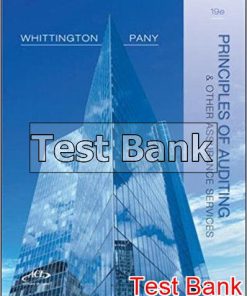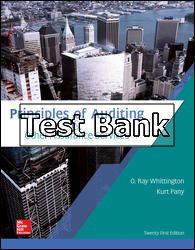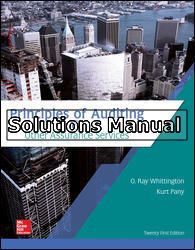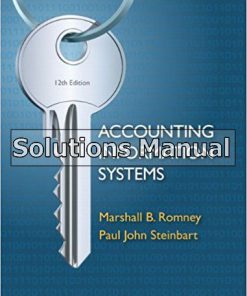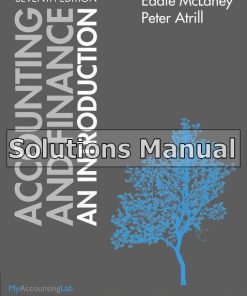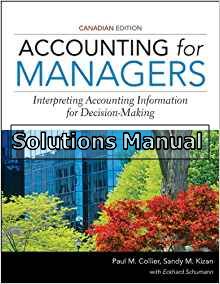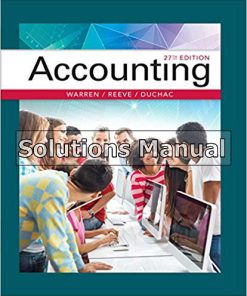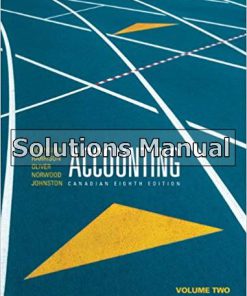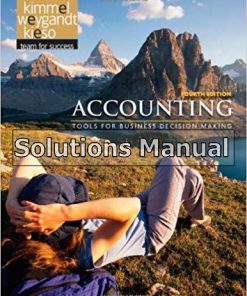Principles of Auditing and Other Assurance Services 19th Edition Whittington Solutions Manual
$26.50$50.00 (-47%)
Principles of Auditing and Other Assurance Services 19th Edition Whittington Solutions Manual.
You may also like
Principles of Auditing and Other Assurance Services 19th Edition Whittington Solutions Manual
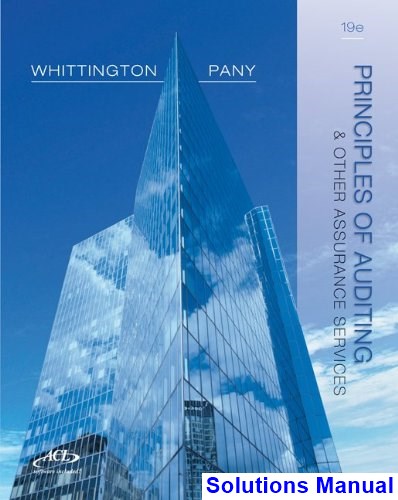
Product details:
- ISBN-10 : 0077804775
- ISBN-13 : 978-0077804770
- Author: Whittington/Pany
Whittington/Pany is our market leader in the auditing discipline. While most textbooks use a cycles approach, Whittington/Pany enlists a balance sheet approach – making it particularly straightforward and user-friendly. The 19th Edition of Principles of Auditing & Other Assurance Services provides a carefully balanced presentation of auditing theory and practice. Written in a clear and understandable manner, it is particularly appropriate for students who have had limited or no audit experience. The approach is to integrate auditing material with that of previous accounting financial, managerial, and systems courses.
Table contents:
PART I INTRODUCTION TO FINANCIAL STATEMENT AUDITING 1 1 An Introduction to Assurance and Financial Statement Auditing 2 The Study of Auditing 5 The Demand for Auditing and Assurance 6 Principals and Agents 6 The Role of Auditing 7 An Assurance Analogy: The Case of the House Inspector 9 Seller Assertions, Information Asymmetry, and Inspector Characteristics 9 Desired Characteristics of the House Inspection Service 9 Relating the House Inspection Analogy to Financial Statement Auditing 10 Management Assertions and Financial Statements 11 Auditing, Attest, and Assurance Services Defined 12 Auditing 13 Attestation 14 Assurance 14 Fundamental Concepts in Conducting a Financial Statement Audit 15 Audit Risk 16 Materiality 17 Evidence Regarding Management Assertions 18 Sampling: Inferences Based on Limited Observations 18 The Audit Process 19 Overview of the Financial Statement Auditing Process 19 Major Phases of the Audit 21 Conclusion 25 Key Terms 26 Review Questions 27 Multiple-Choice Questions 28 Problems 29 Discussion Case 30 Internet Assignments 31 2 The Financial Statement Auditing Environment 34 A Time of Challenge and Change for Auditors 36 Problems and Warning Signs 36 An Explosion of Scandals 36 Government Regulation 37 Back to Basics 38 The Context of Financial Statement Auditing 38 Business as the Primary Context of Auditing 38 A Model of Business 39 Corporate Governance 39 Objectives, Strategies, Processes, Controls, Transactions, and Reports 39 A Model of Business Processes: Five Components 40 The Financing Process 40 The Purchasing Process 40 The Human Resource Management Process 40 The Inventory Management Process 40 The Revenue Process 40 Relating the Process Components to the Business Model 42 Management Assertions 42 Auditing Standards 43 The Roles of the ASB and the PCAOB 43 The 10 Generally Accepted Auditing Standards 44 Three General Standards 44 Three Standards of Field Work 45 Four Standards of Reporting 46 Statements on Auditing Standards?Interpretations of GAAS 46 Ethics, Independence, and the Code of Professional Conduct 47 The Auditor?s Responsibility for Errors, Fraud, and Illegal Acts 48 Audit Reporting 49 Generally Accepted Accounting Principles as Audit Criteria 50 The Auditor?s Standard Unqualified Audit Report 50 Reasons for Departures from an Unqualified Audit Report 52 Other Types of Audit Reports 52 Public Accounting Firms 53 Organization and Composition 53 Types of Audit, Attest, and Assurance Services 54 Audit Services 55 Attest Services 56 Assurance Services 57 Other Nonaudit Services 58 Types of Auditors 59 External Auditors 59 Internal Auditors 61 Government Auditors 61 Forensic Auditors 62 Organizations That Affect the Public Accounting Profession 62 American Institute of Certified Public Accountants (AICPA) 64 Securities and Exchange Commission (SEC) 65 Public Company Accounting Oversight Board (PCAOB) 65 Financial Accounting Standards Board (FASB) 66 Conclusion 66 Key Terms 67 Review Questions 68 Multiple-Choice Questions 69 Problems 72 Discussion Case 74 Internet Assignments 75 PART II BASIC AUDITING CONCEPTS: RISK ASSESSMENT, MATERIALITY, AND EVIDENCE 77 3 Risk Assessment and Materiality 78 Audit Risk 80 The Audit Risk Model 80 Use of the Audit Risk Model 82 The Auditor?s Risk Assessment Process 84 Management?s Strategies, Objectives, and Business Risks 84 Business Risks and the Risk of Material Misstatement 84 Understanding the Entity and Its Environment 85 Auditor?s Risk Assessment Procedures 90 Identifying Business Risks 92 Assessing the Risk of Material Misstatement Due to Error or Fraud 92 Types of Misstatements 93 Conditions Indicative of Material Misstatement Due to Fraud 94 The Fraud Risk Identification Process 95 Discussion among the Audit Team 96 Inquiries of Management and Others 97 Fraud Risk Factors 97 The Auditor?s Response to the Results of the Risk Assessments 102 Evaluation of Audit Test Results 104 Documentation of the Auditor?s Risk Assessment and Response 105 Communications about Fraud to Management, the Audit Committee, and Others 107 Limitations of the Audit Risk Model 109 Materiality 109 Steps in Applying Materiality 110 An Example 116 Key Terms 118 Review Questions 119 Multiple-Choice Questions 119 Problems 121 Discussion Cases 123 Internet Assignments 125 4 Audit Evidence and Audit Documentation 130 The Relationship of Audit Evidence to the Audit Report 132 Management Assertions 133 Assertions about Classes of Transactions and Events during the Period 134 Assertions about Account Balances at the Period End 134 Assertions about Presentation and Disclosure 135 Audit Procedures 136 The Concepts of Audit Evidence 137 The Nature of Audit Evidence 138 The Competence of Audit Evidence 138 The Sufficiency of Audit Evidence 140 The Evaluation of Audit Evidence 140 Audit Procedures for Obtaining Audit Evidence 141 Inspection of Records or Documents 141 Inspection of Tangible Assets 142 Reperformance 143 Recalculation 143 Scanning 143 Inquiry 143 Observation 144 Confirmation 145 Analytical Procedures 145 Reliability of the Types of Evidence 146 Audit Documentation 147 Objectives of Audit Documentation 147 Content of Audit Documentation 147 Examples of Audit Documentation 149 Format of Audit Documentation 151 Organization of Audit Documentation 152 Ownership of Audit Documentation 154 Audit Document Archiving and Retention 154 Key Terms 155 Review Questions 157 Multiple-Choice Questions 157 Problems 159 Discussion Cases 161 Internet Assignments 163 PART III PLANNING THE AUDIT, AND UNDERSTANDING AND AUDITING INTERNAL CONTROL 165 5 Audit Planning and Types of Audit Tests 166 Client Acceptance and Continuance 168 Prospective Client Acceptance 168 Continuing Client Retention 170 Establishing the Terms of the Engagement 170 The Engagement Letter 170 Internal Auditors 170 The Audit Committee 175 Preplanning 176 Determine the Audit Engagement Team Requirements 176 Assess Independence 176 Assess Risks and Establish Materiality 177 Planning the Audit 177 Assess a Preliminary Level for Control Risk by Account and Assertion 178 Assess the Possibility of Illegal Acts 178 Identify Related Parties 179 Conduct Preliminary Analytical Procedures 180 Develop an Overall Audit Strategy and Prepare Audit Programs 181 Consider Additional Value-Added Services 182 Types of Audit Tests 183 Risk Assessment Procedures 183 Tests of Controls 183 Substantive Procedures 184 Dual Purpose Tests 185 Substantive Analytical Procedures 185 Analytical Procedures 185 Purposes of Analytical Procedures 185 Substantive Analytical Procedures Decision Process 186 Final Analytical Procedures 198 The Audit Testing Hierarchy 199 An ?Assurance Bucket? Analogy 201 Advanced Module: Selected Financial Ratios 203 Selected Financial Ratios Useful as Analytical Procedures 203 Short-Term Liquidity Ratios 203 Activity Ratios 204 Profitability Ratios 205 Coverage Ratios 206 Key Terms 206 Review Questions 207 Multiple-Choice Questions 208 Problems 211 Discussion Cases 215 Internet Assignments 217 6 Internal Control in a Financial Statement Audit 218 Introduction 220 Internal Control 220 Definition of Internal Control 220 Controls Relevant to the Audit 220 Components of Internal Control 221 The Effect of Information Technology on Internal Control 222 Planning an Audit Strategy 223 Substantive Strategy 226 Reliance Strategy 226 Obtain an Understanding of Internal Control 228 Overview 228 Control Environment 229 The Entity?s Risk Assessment Process 232 Information Systems and Communication 234 Control Procedures 235 Monitoring of Controls 236 The Effect of Entity Size on Internal Control 237 The Limitations of an Entity?s Internal Control 237 Documenting the Understanding of Internal Control 239 Assessing Control Risk 240 Identifying Specific Controls That Will Be Relied Upon 241 Performing Tests of Controls 241 Concluding on the Achieved Level of Control Risk 242 Documenting the Assessed Level of Control Risk 242 An Example 242 Substantive Procedures 243 Timing of Audit Procedures 244 Interim Tests of Controls 245 Interim Substantive Procedures 245 Auditing Accounting Applications Processed by Service Organizations 246 Communication of Internal Control?Related Matters 247 Advanced Module 1: Types of Controls in an IT Environment 249 General Controls 249 Application Controls 251 Advanced Module 2: Flowcharting Techniques 254 Symbols 254 Organization and Flow 255 Key Terms 256 Review Questions 257 Multiple-Choice Questions 257 Problems 260 Discussion Case 262 Internet Assignments 263 7 Auditing Internal Control over Financial Reporting in Conjunction with an Audit of Financial Statements 264 Management Responsibilities under Section 404 266 Auditor Responsibilities under Section 404 266 Internal Control over Financial Reporting Defined 267 Internal Control Deficiencies Defined 267 Control Deficiency 267 Significant Deficiency 268 Material Weakness 268 Likelihood and Magnitude 268 Management?s Assessment Process 269 Management?s Documentation 271 Framework Used by Management to Conduct Its Assessment 272 Performing an Audit of Internal Control over Financial Reporting 272 The Audit Process 272 Planning the Engagement 273 Evaluating Management?s Assessment Process 273 Obtaining an Understanding of Internal Control over Financial Reporting 274 Evaluting Design Effectiveness of Controls 279 Testing and Evaluating Operating Effectiveness of Controls 279 Forming an Opinion on the Effectiveness of Internal Control over Financial Reporting 284 Written Representations 286 Auditor Documentation Requirements 286 Reporting on Internal Control over Financial Reporting 287 Management?s Report 287 The Auditor?s Report 288 Additional Required Communications in an Audit of Internal Control over Financial Reporting 294 Integrating the Audits of Internal Control and Financial Statements 295 Effect of the Audit of Internal Control on the Financial Statement Audit 295 Effect of the Financial Statement Audit on the Audit of Internal Control 296 Advanced Module 1: Special Considerations for an Audit of Internal Control 297 Using the Work of Others 297 Testing Internal Control When a Company Has Multiple Locations or Business Units 299 Use of Service Organizations 301 Safeguarding of Assets 303 Advanced Module 2: Computer-Assisted Audit Techniques 303 Generalized Audit Software 304 Custom Audit Software 305 Test Data 305 Key Terms 306 Review Questions 307 Multiple-Choice Questions 308 Problems 310 Internet Assignments 315 PART IV STATISTICAL AND NONSTATISTICAL SAMPLING TOOLS FOR AUDITING 317 8 Audit Sampling: An Overview and Application to Tests of Controls 318 Introduction 320 Definitions and Key Concepts 322 Audit Sampling 322 Sampling Risk 322 Confidence Level 323 Tolerable and Expected Error 324 Audit Evidence Choices That Do and Do Not Involve Sampling 324 Types of Audit Sampling 326 Nonstatistical versus Statistical Sampling 326 Types of Statistical Sampling Techniques 327 Attribute Sampling Applied to Tests of Controls 328 Planning 328 Population Size 334 Performance 334 Sample Selection 334 Evaluation 337 An Example of an Attribute-Sampling Plan 339 Determine the Test Objective (Step 1) 339 Define the Population Characteristics (Step 2) 339 Determine the Sample Size (Step 3) 340 Select Sample Items (Step 4) 342 Perform the Audit Procedures (Step 5) 343 Calculate the Sample Deviation and the Computed Upper Deviation Rates (Step 6) 346 Draw Final Conclusions (Step 7) 347 Nonstatistical Sampling for Tests of Controls 349 Determining the Sample Size 349 Selecting the Sample Items 350 Calculating the Computed Upper Deviation Rate 350 Advanced Module: Considering the Effect of the Population Size 351 Key Terms 352 Review Questions 353 Multiple-Choice Questions 353 Problems 356 Discussion Case 359 9 Audit Sampling: An Application to Substantive Tests of Account Balances 362 Sampling for Substantive Tests of Details of Account Balances 364 Monetary-Unit Sampling 365 Advantages 366 Disadvantages 366 Applying Monetary-Unit Sampling 367 Planning 367 Computing Sample Sizes Using the Attribute-Sampling Tables 371 Computing Sample Sizes Using ACL 371 Performance 372 Evaluation 374 An Extended Example 374 Basic Precision 375 Misstatements Detected 376
People also search:
principles of auditing and other assurance services pdf
principles of auditing and other assurance services
principles of auditing and other assurance services 22nd edition pdf
principles of auditing & other assurance services
principles of auditing & other assurance services pdf free

